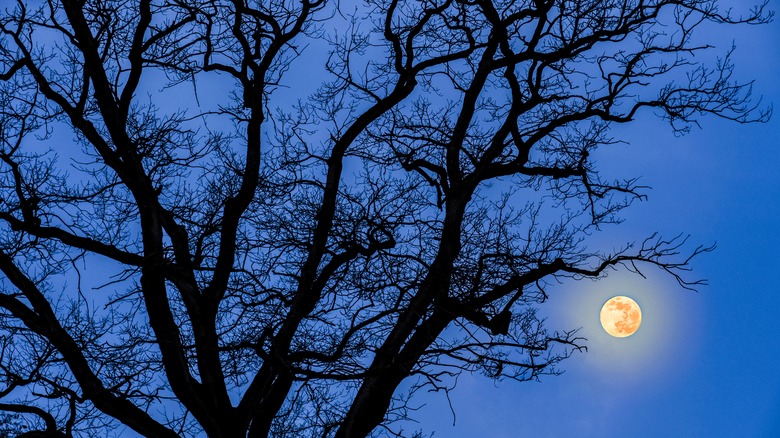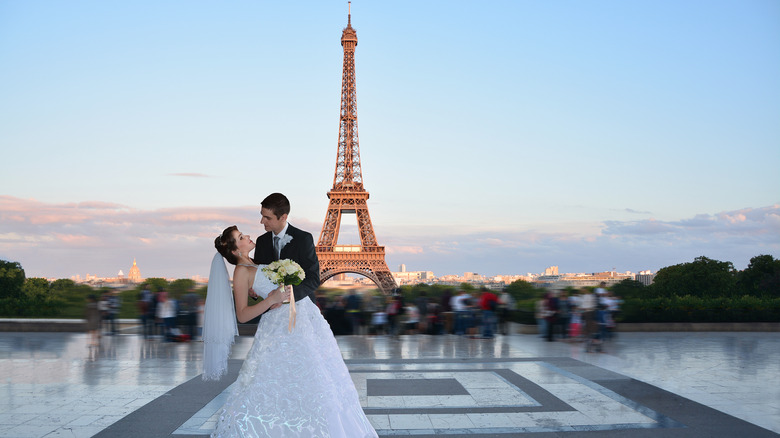The True Origins Of The Term Honeymoon
Modern honeymoons are post-nuptial romantic escapes so the newlyweds can decompress and celebrate surviving their wedding reception. Couples celebrate their brand new union by having oodles of uh, intimacy, and drinking too much champagne in picturesque, expensive locales. But a relaxing after-wedding vacation is a far cry from the true origins of the word honeymoon. So what does the term honeymoon mean, and where does it come from? The word honeymoon originates from the Old English expression "hony moone." Let's break it down.
According to Dictionary.com, "hony" represents the sweetness of the new union. It also harkens back to the old European tradition of supplying newlyweds with sufficient mead for a month. One can see the logic. If you spend the month of marriage with a mead buzz, your partner's annoying idiosyncrasies won't wear on your nerves. Yet.
The Oxford English Dictionary (via Insider) claims the first native-English usage of the word honeymoon, which appeared in a collection of stories penned by Maria Edgeworth in 1804, contained the English debut of the term honeymoon. There were other references to honeymoons in older literature as well.
Bride abduction
The sinister side of honeymoon history is the practice of bride theft which, like mead drinking, dates back to the era of Atilla the Hun, between A.D. 433 and 453 (via World History).
According to The Journal of Roman Studies, although King Constantine vigorously denounced bride theft, marriage by abduction continued unabated. William Shepard Walsh described in his book "Curiosities of Popular Customs and of Rites, Ceremonies, Observances, and Miscellaneous Antiquities" how in Northern Europe, husbands-to-be kidnapped the woman they hoped to wed, which is a slight improvement over getting clubbed over the head and dragged unconscious to some guy's cave. The groom's friends guarded the couple in case the bride's relatives of the bride demanded her return. Once the bride's family and friends gave up searching, the newlyweds returned to the husband's village. One of the likely contenders for the true origin of the word honeymoon is the practice of marriage by abduction. Now that's romance!
Mead and the moon
Brides reports that the term honeymoon originated in Scandinavia. Custom dictated that newlyweds must drink a cup of honey mead daily during their first month of marriage. So the "honey" in honeymoon is assumed to reference the mead drinking tradition. But what's the scoop on "moon"? Several theories exist that might explain the involvement of the moon. One lunar cycle lasts approximately a month, which happens to be the length of time newly married couples chugged down a daily glass of mead. It is also about how long it takes for the initial newlywed glow to wear off.
Richard Huloet, a 16th-century English lexicographer, wrote (via "How to Be Married"): "Hony mone, a term proverbially applied to such as be newly married, which will not fall out at the first, but th'one loveth the other at the beginning exceedingly, the likelihood of their exceadinge love appearing to aswage, ye which time the vulgar people call the hony mone."
I hope no one ever lets this guy do a wedding toast.
British adopt the Indian bridal tour
By the 1800s, British newlyweds began practicing an Indian tradition called the bridal tour. Country Living reports that the custom gained popularity in Europe during the 1820s as well. The new couple would travel through Europe with both sides of the family in tow. Clearly, the newly-married pair had little to no alone time. Newlyweds often incorporated bridal tours to visit family members who couldn't make it to the wedding. The bridal tour was a custom that only the very wealthy could afford to indulge in. A honeymoon tour usually lasted about a month, which became the standard amount of time allotted for a honeymoon. If you could afford to do so, of course. The CEO of Honeyfund, Sara Margulis, says that the Honeymoon, as we recognize it, didn't evolve until the late 1800s.
So newlyweds taking post-nuptials vacations purely as a pleasure trip were a boon for European tourism in the late 1800s. However, this honeymoon trend attracted many nay-sayers. Some physicians were concerned that the "weaker" sex couldn't withstand such a long trip. The weaker sex could endure birthing 10 babies and running a household, but a nice jaunt around the continent was just too much for the poor dears.
American honeymoons
When the honeymoon trend made it across the pond to the United States, the honeymoon had long since evolved into a post-wedding vacation. Americans, however, didn't feel the need to travel to Europe (via CNN). The United States is a massive and diverse country with plenty of perfect honeymoon destinations within its borders, so residents would generally remain within their own country for their honeymoon. On the other hand, Europeans almost exclusively left their native countries during their honeymoons. Of course, relatively speaking, Western Europe comprises a smaller area than the United States, so the logic behind Americans remaining in their own country makes perfect sense.
According to PlanetWare, the U.S. boasts perfect honeymoon destinations such as Maui, Hawaii; Laguna Beach, California; Key West, Florida; New Orleans, Louisiana; and Big Sur, California. The United States is a country of outstanding beauty and versatility, so why dig out the passport if you're an American?
The long journey of the word honeymoon
Language is never static. It is ever-evolving. Words like honeymoon and the origins of their meaning are perfect examples of how etymology morphs and changes over the centuries, reinventing how we communicate and interact with each other. I doubt our ancestors pictured any of us being married by an Elvis impersonator in Vegas.
Honeymoons are never static either. The days of long bridal tours are a thing of the past, but new traditions have sprung up in its place. For example, destination weddings are very popular. Beach weddings are also particularly fashionable, with the couple exchanging vows barefoot in the sand. It makes a lot of sense to tie the knot where you're honeymooning. But it can be a very expensive proposition for your friends and family, which pares down that wedding list quite nicely. If you can't elope, a destination wedding is the next best thing.





